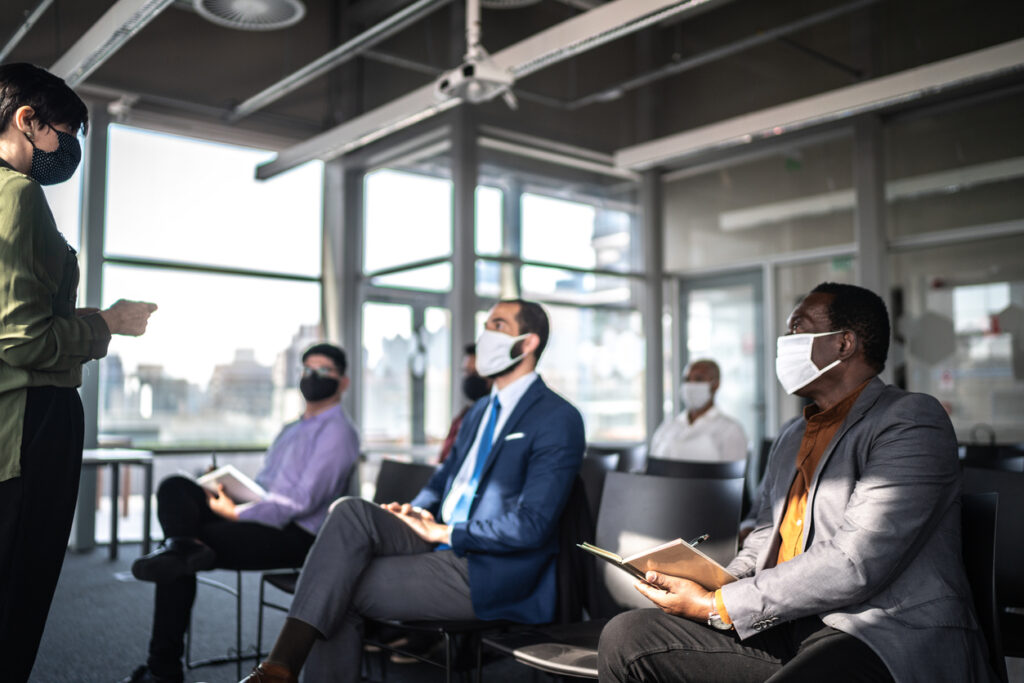Is it time to think about resuming face-to-face training? It would be completely natural to be feeling a little anxious about your first day back at the front of the room. As I reflect here on my first post-lockdown face-to-face training experience, I’ll look at the planning, safety and socially distanced activities, as well as feedback from the participants about their experience. Finally, I’ll offer an insight on the surprising benefits of this approach.
Planning and safety
I’m sure you’ll have been thinking about spacing of participants, taking socially distanced breaks, adopting flexible one-at-a-time comfort breaks and bagged lunches. Other ideas include allowing participants to pick up their own materials and (either new or sanitised) marker pens and toys from the front (to keep) rather than laying out your room beforehand, or eliminating materials altogether and going paperless. I’d strongly advise clear plastic face visors rather than paper or material face coverings, for comfort and to aid your participants’ understanding.
Socially distanced activities
One of the key things we’ve all learned during lockdown is how to run highly interactive, engaging learning activities online:
| From | To |
| Movement activities standing on a mat or in masking tape quadrants on the floor. | Moving stamps around a model on a slide in Zoom or moving avatars around a MIRO board whilst peer-coaching in breakout. |
| Moving post-it-notes around a flip chart to design a process. | Adding or moving post-it-notes virtually around a MIRO board. |
| Designing a team alliance as a group board blast . | Creating a word cloud in Adobe Connect, Menti or Sli.do. |
Don’t be too fast to turn your back on these tools when you resume face-to-face training. Using these virtual collaboration tools whilst in a room together can help you to maintain social distancing whilst working in small groups via breakouts, and allows participants to discover learning for themselves. Even if it’s just a case of working on a document together by sharing screens on Zoom, you can gain the benefits of sharing the same base document, whilst sitting far enough apart for safety but close enough to chat comfortably. I predict the world of learning will be far more blended than we ever considered before, and we’ll quickly adapt to using virtual tools whilst still face-to-face and not just as pre, mid and post-module work.
How did the participants find it?
Here’s a sample of some of the feedback we received from participants:
“It's been interesting transitioning from seeing no one bar family and masked people in Tesco, to a nearly full office and a face-to-face training course. It’s a welcome change and a snapshot of days gone. Keeping socially distant during the course has been fairly simple thanks to the planning”.
“Technology makes collaboration easier, using the Miro board was enjoyable and helpful. While a few technical difficulties did lose us a few minutes, once we got the hang of it, the rest was plain sailing”.
“Having my tissues, secret snacks and work email at hand has led to increased comfort during the course and I haven't had to catch up on emails in the evening as I have fired the replies off in the breaks”.
A surprising brain friendly learning benefit
In my first face-to-face training, I chose to deliver the training in the office with participants at their permanent desk or a free (sanitised) hot-desk. I was lucky to have the luxury of working with an intact team with a small number of visitors from another site hot desking. Everyone in the room was participating in the training, so there was no one trying to complete their day-job in a distracting environment.
It is a well examined phenomenon in the world of neuroscience that learning is retained and embedded up to 50% more effectively if the learning happens in the actual place of work (context dependent memory). Despite this, I don’t believe I’ve met any trainers who’ve delivered a full training course in the office. In the past, desk-based training has been limited to short sessions of ‘sitting next to Nellie’ to train on a specific task. Instead, we trainers prefer to be in a separate room, or better still, completely off-site. I too, have struggled with this dilemma in the past – on the one hand knowing that learning is more effective in the place of application, but fighting the fear of constant distractions (e.g. phone calls, people ‘popping in’ to ask a question, etc).
My experience in this event was that people outside of the team respected the fact that training was happening and kept away. Some simple posters on the office doors or windows could help to encourage people to stay away until break times. In this instance there were no more interruptions than you’d expect if you were in the boardroom. In fact, just one person came in to chat – a very senior leader who had previously declined to join in for a formal Q&A at the end of the programme, but it seems he found it much more comfortable to pop in for just a few minutes during the programme to lend his support, and I found the interruption very natural, comfortable, helpful and supportive.
So what next?
I worry that more learning will happen virtually for quite some time to come. It is, after all, shorter, more budget-friendly, and requires less travel. Although there are ways to make it interactive, achieve good learning outcomes and to feel relatively social, no one single learning media can be a panacea. The benefits of face-to-face training must not be overlooked.
Most of the participants commented during the session that they were really enjoying the social learning that happens in person. Many said that they had been suffering some ‘virtual team fatigue’ and that sometimes it is just easier to ask the ‘stupid’ questions when it’s clear that you have much more time in a full day or two of face-to-face training, no matter how welcoming and open the trainer and group are in virtual team meetings. For this reason, I feel a leap into truly blended learning – both inside and outside the training room – could achieve greater learning retention and allow knowledge to become better embedded.
Interested in this topic? Read Four key learning trends in 2020.












One Response
Well done Lindsey, sounds
Well done Lindsey, sounds like a successful session. I’m not sure I will be rushing back just yet and clients are enjoying the zoom virtual training atm. I like the fact you have combined the technology with the physical presence gaining the best of both worlds.